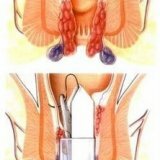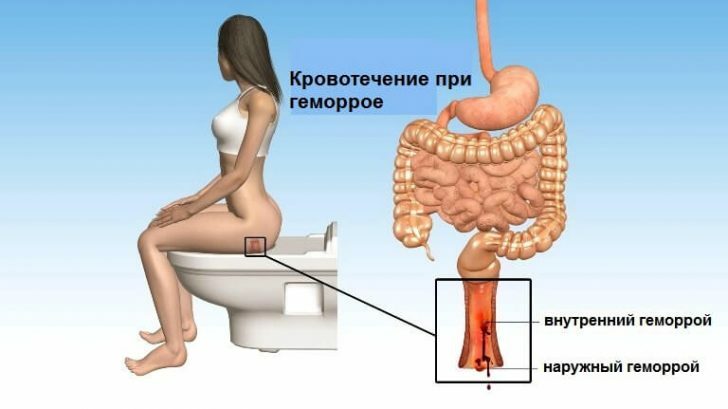Minimally invasive methods of treating hemorrhoids
 In the light of the creation of new technologies and efficient sclerosing devices and devices, in minimally invasive( non-surgical) methods of treatment of various diseases, more and more widely are accepted. The widespread use of minimally invasive methods of treatment is noted in the field of plastic surgery, in the field of cardiovascular disease treatment.
In the light of the creation of new technologies and efficient sclerosing devices and devices, in minimally invasive( non-surgical) methods of treatment of various diseases, more and more widely are accepted. The widespread use of minimally invasive methods of treatment is noted in the field of plastic surgery, in the field of cardiovascular disease treatment. Recently, non-surgical procedures have been successfully used to treat hemorrhoids. Sclerous therapy, infrared photocoagulation, ligation latex rings hemorrhoids, and also suture ligation of hemorrhoids under the control of dopplerometry electrocoagulation, the use of cryodistruction and the removal of hemorrhoids radiosurgical way - all this on minimally invasive methods of treating hemorrhoids.
According to the frequency of using the method of treatment of the disease ligation with latex rings of hemorrhoids takes a leading position. The percentage of use of this method is 82% of the total number of procedures aimed at treating hemorrhoids. A few rarely use sclerotherapy, as well as infrared and electrocoagulation. The frequency of use of these methods is associated with their small traumatism and a minor degree of soreness.
The main indications to the use of a minimally invasive technique are:
· if the patient has only a pathological condition of internal hemorrhoids;
· if there is no inflammation of the anal canal and perineum in the patient's history;
The procedure of infrared photocoagulation consists in the action of the hemorrhoidal node on the leg, that is, the action of the heat flux created by the infrared rays on it. The light infrared flow, penetrating into the tissue of the node, is transformed into heat, due to which coagulation of tissues takes place. Internal bleeding hemorrhoids of the first and second degree, small hemorrhages of internal hemorrhoids - are indications for the procedure of infrared photocoagulation. The duration of exposure of the infrared ray to the tissue is about 1 to 3 seconds. During one procedure, it is possible to act on three sites, repeat the procedure after 12-14 days after the first procedure. With the proven technique and precise guidance of the photocoagulator for the patient, the procedure is practically painless.
In recent years, foreign and domestic coloproctologists have widely used a simple but effective outpatient method of treatment - ligation of with latex rings of hemorrhoids. The procedure consists in throwing a hemorrhoidal knot, special latex rubber, onto the leg with a special instrument. Latex leads to squeezing the knot of the node and stopping blood circulation inside it. On the 11-14th day after manipulation, the latex is rejected with the tissues of the node. Since the eruption of tissues with the elastic ligation occurs gradually, a stump from the connective tissue is formed at the site of rejection of the hemorrhoidal node. The whole procedure will take no more than 10 minutes.
Method of suture ligation of hemorrhoids.
Methods of treatment hemorrhoids very are effective when using the method of suture ligation of hemorrhoids under the control of ultrasonic dopplerometry. This technique allows reliable localization of hemorrhoidal branches in the submucosal layer of the rectum, bandaging them and stopping access to arterial blood. The essence of the method lies in the diagnosis of the distal branches and the subsequent stitching of each artery with vikril sutures.
Sclerosing drugs for the treatment of hemorrhoids have been used for a long time. The effectiveness of the method lies not only in the long-term development of the technique, but also in the use of sclerotic drugs of a new generation, as well as in the use of special equipment( syringe, needle, anascope with lighting, etc.).
There are three types of sclerotizing drugs: detergents, osmotic solutions and corrosive preparations. Detergents cause coagulation of endothelial proteins. Corrosive preparations cause destruction of internal, submucosal and muscular layers of the rectum. Osmotic preparations are characterized by a longer period of exposure and a greater amount of drug administration.
Contraindications to the use of sclerosing drugs are inflammation of the anal canal and perineum, paraproctitis, acute hemorrhoids, anal fissure, and combined forms of hemorrhoids.
Combination of methods of treatment.
Minimally invasive methods include the combination of various methods of treating hemorrhoids and this is considered to be the most effective way. They combine ligation and scleropathy, as well as well-combined ligation and infrared coagulation, in combination methods yield good results. For example, the combination of sclerosing treatment and infrared photocoagulation leads to a reduction in the mass of the hemorrhoidal node. The combination of ligation of hemorrhoids by latex rings and suture ligation under the control of Doppler ultrasound can be used as outpatient treatment of the patient, both in early and late stages of the disease.
The criterion of good results of a combination of infrared photocoagulation, sclerosing treatment and ligation of latex rings is the cessation of hemorrhage and prolapse of hemorrhoids. These methods have a number of benefits, which consist in the simple technique of execution, high performance, out-patient treatment, safe and well tolerated by the patient, without affecting its ability to work, as well as the low cost of the procedure.
The combination of these or those methods depends on the nature and severity of pathological changes. The optimal combination of methods should be selected by the surgeon, directly for each patient, based on a thorough study of the history of his illness and the course of the course of the disease.



